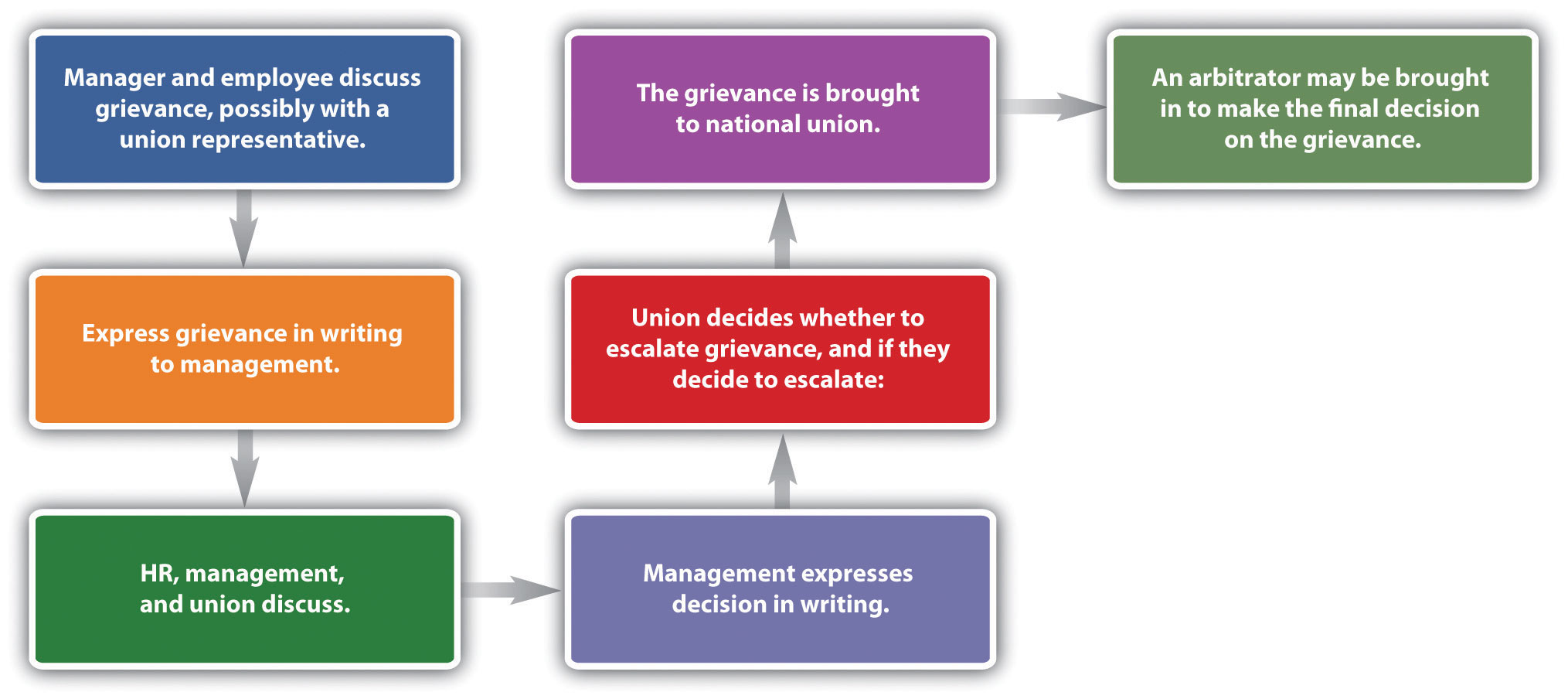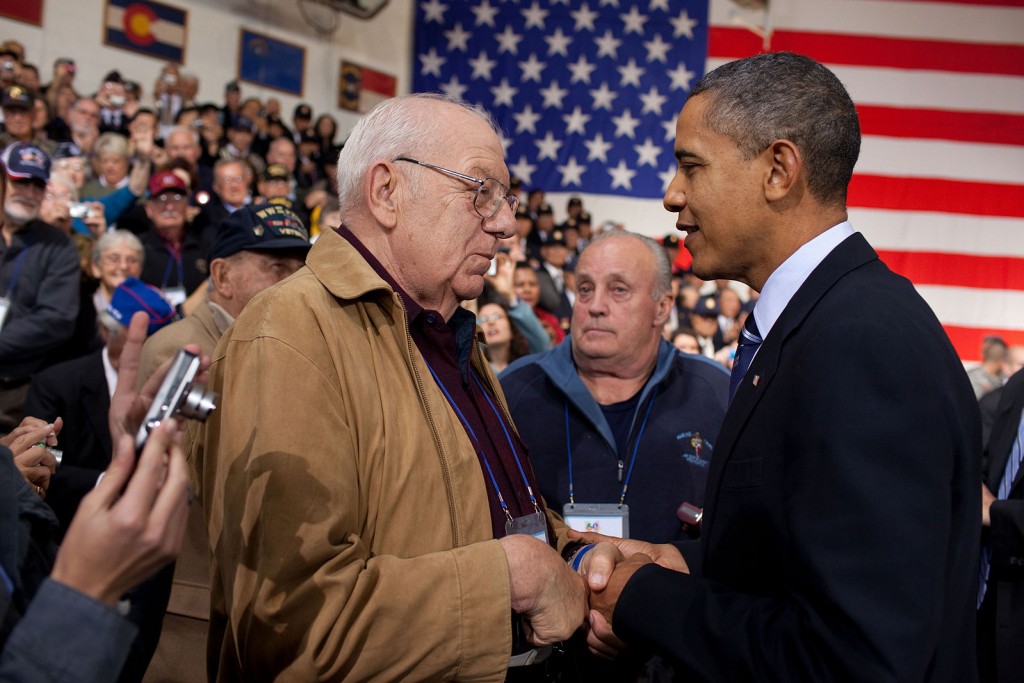12.3 Administration of the Collective Bargaining Agreement
A grievance procedure or process is normally created within the collective bargaining agreement. The grievance procedure outlines the process by which grievances over contract violations will be handled. This will be the focus of our next section.
Procedures for Grievances
A violation of the contract terms or perception of violation normally results in a grievance. The process is specific to each contract, so we will discuss the process in generalities. A grievance is normally initiated by an employee and then handled by union representatives. Most contracts specify how the grievance is to be initiated, the steps to complete the procedure, and identification of representatives from both sides who will hear the grievance. Normally, the HR department is involved in most steps of this process. Since HRM has intimate knowledge of the contract, it makes sense for them to be involved. The basic process is shown in Figure 12.8 “A Sample Grievance Process”.
Figure 12.8 A Sample Grievance Process
 Process in order: manager and employee discuss grievance, possibly with a union representative; express grievance in writing to management; HR, management, and union discuss; management expresses decision in writing; union decides whether to escalate grievance, and if they decide to escalate; the grievance is brought to national union; an arbitrator may be brough in to make the final decision on the grievance." width="" />
Process in order: manager and employee discuss grievance, possibly with a union representative; express grievance in writing to management; HR, management, and union discuss; management expresses decision in writing; union decides whether to escalate grievance, and if they decide to escalate; the grievance is brought to national union; an arbitrator may be brough in to make the final decision on the grievance." width="" />
The first step is normally an informal conversation with the manager, employee, and possibly a union representative. Many grievances never go further than this step, because often the complaint is a result of a misunderstanding.
If the complaint is unresolved at this point, the union will normally initiate the grievance process by formally expressing it in writing. At this time, HR and management may discuss the grievance with a union representative. If the result is unsatisfactory to both parties, the complaint may be brought to the company’s union grievance committee. This can be in the form of an informal meeting or a more formal hearing.
After discussion, management will then submit a formalized response to the grievance. It may decide to remedy the grievance or may outline why the complaint does not violate the contract. At this point, the process is escalated.
Further discussion will likely occur, and if management and the union cannot come to an agreement, the dispute will normally be brought to a national union officer, who will work with management to try and resolve the issue. A mediator may be called in, who acts as an impartial third party and tries to resolve the issue. Any recommendation made by the mediator is not binding for either of the parties involved. Mediators can work both on grievance processes and collective bargaining issues. For example, when the National Football League (NFL) and its players failed to reach a collective bargaining agreement, they agreed to try mediation (Associated Press, 2011). In this case, the agreement to go to mediation was a positive sign after several months of failed negotiations. In the end, the mediation worked, and the NFL players started the 2011–12 season on time. In Washington State (as well as most other states), a nonprofit organization is available to assist in mediations (either grievance or collective bargaining related) and arbitrations. The goal of such an organization is to avoid disruptions to public services and to facilitate the dispute resolution process. In Washington, the organization is called the Public Employment Relations Commission (PERC). Figure 12.9 “The Mediation Process for the Public Employment Relations Commission in Washington State” shows the typical grievance handling process utilizing the free PERC services.
Figure 12.9 The Mediation Process for the Public Employment Relations Commission in Washington State
See Chapter 391-55 WAC. Grievance mediation resolves grievances under existing contracts. The “normal” flow is:
- Request for Grievance Mediation (PERC Form G-1 or equivalent) is filed at PERC’s Olympia office. PERC will only act on requests where the parties have agreed, in advance, to submit any unresolved issues to final and binding arbitration.
- A PERC staff mediator is assigned, and the mediator contacts the parties to schedule a meeting. This is accomplished informally, but may be confirmed by a letter or e-mail messages.
- Mediation sessions are usually held in employer offices or union offices, unless the parties arrange and pay the costs for other meeting spaces. PERC has only limited facilities for mediation in agency offices.
- The mediator meets with parties to discuss the issues, explore alternatives, and arrive at an agreement to resolve the particular grievance(s) submitted.
- The mediator will not conduct an evidential hearing, as would be done in arbitration.
- The mediator will not issue a formal opinion, as would be done in arbitration, but may send a letter to confirm a settlement reached or recommendation(s) made.
- Mediators draw on their knowledge and experiences but do not have a power of compulsion.
- Communications between the mediator and the parties, as well as the mediator’s notes, are confidential. A mediator cannot be called to give testimony about the mediation in any subsequent proceeding.
If no resolution develops, an arbitrator might be asked to review the evidence and make a decision. An arbitrator is an impartial third party who is selected by both parties and who ultimately makes a binding decision in the situation. Thus arbitration is the final aspect of a grievance.
Some examples of grievances might include the following:
- One employee was promoted over another, even though he had seniority.
- An employee doesn’t have the tools needed to perform his or her job, as outlined in the contract.
- An employee was terminated, although the termination violated the rules of the contract.
- An employee was improperly trained on chemical handling in a department.

Working with a union requires the HR professional to be a good communicator and to view the union-management arrangement as a successful partnership.
Most grievances fall within one of four categories. There are individual/personal grievances , in which one member of the union feels he or she has been mistreated. A group grievance occurs if several union members have been mistreated in the same way. A principle grievance deals with basic contract issues surrounding seniority or pay, for example. If an employee or group is not willing to formally file a grievance, the union may file a union or policy grievance on behalf of that individual or group.
The important things to remember about a grievance are that it should not be taken personally and, if used correctly can be a fair, clear process to solving problems within the organization.
Grievance Process for Flight Attendants
This video shows a philosophical perspective of the grievance process for the Association of Flight Attendants union.
Key Takeaways
- The grievance process is a formal process to address any complaints about contract violations.
- The grievance process varies from contract to contract. It is an important part of the contract that ensures a fair process for both union members and management.
- HR is normally involved in this process, since it has intimate knowledge of the contract and laws that guide the contract.
- The grievance process can consist of any number of steps. First, the complaint is discussed with the manager, employee, and union representative. If no solution occurs, the grievance is put into writing by the union. Then HR, management, and the union discuss the process, sometimes in the form of a hearing in which both sides are able to express their opinion.
- Management then expresses its decision in writing to the union.
- If the union decides to escalate the grievance, the grievance may be brought to the national union for a decision. At this point, an arbitrator may be brought in, suitable to both parties, to make the final binding decision.
- There are four main types of grievances. First, the individual grievance is filed when one member of the union feels mistreated. A group grievance occurs when several members of the union feel they have been mistreated and file a grievance as a group. A principle grievance may be filed on behalf of the union and is usually based on a larger issue, such as a policy or contract issue. A union or policy grievance may be filed if the employee does not wish to file individually.
- Grievances should not be taken personally and should be considered a fair way in which to solve problems that can come up between the union and management.
Exercise
- What are the advantages of a grievance process? What disadvantages do you see with a formalized grievance process?

 Process in order: manager and employee discuss grievance, possibly with a union representative; express grievance in writing to management; HR, management, and union discuss; management expresses decision in writing; union decides whether to escalate grievance, and if they decide to escalate; the grievance is brought to national union; an arbitrator may be brough in to make the final decision on the grievance." width="" />
Process in order: manager and employee discuss grievance, possibly with a union representative; express grievance in writing to management; HR, management, and union discuss; management expresses decision in writing; union decides whether to escalate grievance, and if they decide to escalate; the grievance is brought to national union; an arbitrator may be brough in to make the final decision on the grievance." width="" />